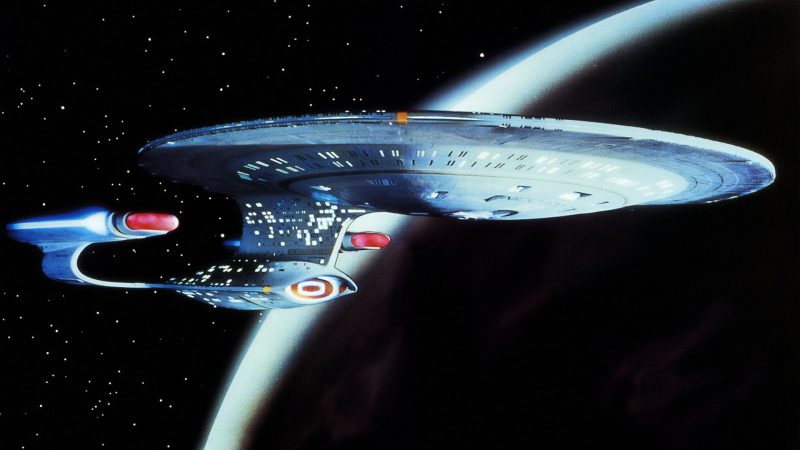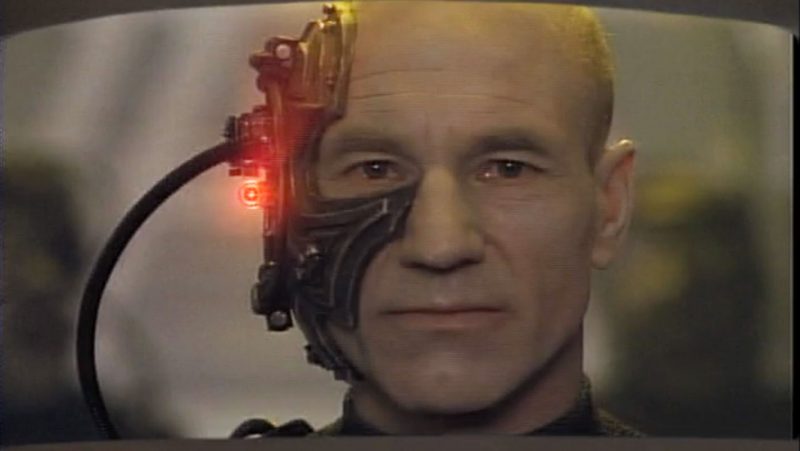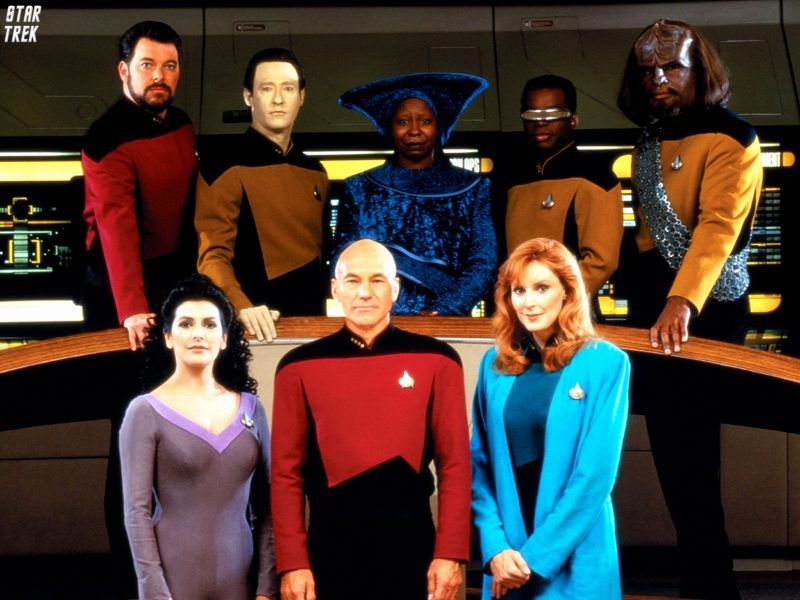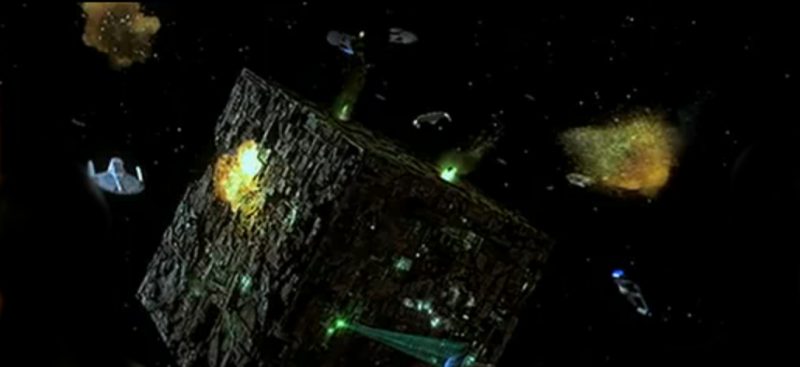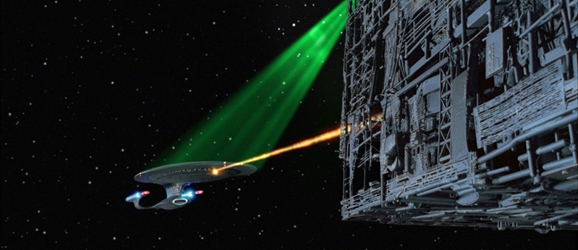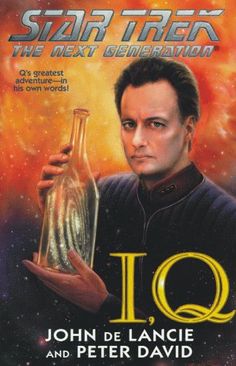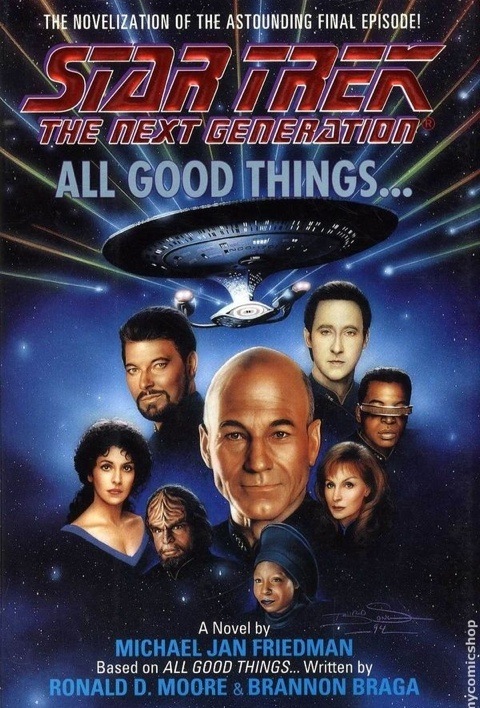Where were you in autumn of 1987?
That question could be asked of any date in time. If one was a television junkie and especially a science fiction aficionado, then one cannot forget such an important time in history. Thirty years ago Star Trek was reborn and revitalized in the form of a new series. It was entitled, Star Trek: The Next Generation. It took nearly 20 years after the original series ended to get this on the air, but there it was in all its luster. While the original series was still going strong with four feature films and a fifth on its way, fans had a second venue to delve into the expanding world of Star Trek. It was a new ship, new crew, new outfits, and new concepts to explore. New fans to the Star Trek universe could follow the adventures each week like the generation before them. The older fans could compare these adventures to that of the original crew. All fans could watch as their explorations took them beyond the alpha quadrant and into the beta and delta quadrants.
While it was not a shining example of the Star Trek remembered by the older generation, it did feature new technology and incorporate new sciences with a sleek new look, and updated special effects. With all of this new stuff, there came some bumps that needed to be hammered out. While the first season was ok and generally good enough to merit a second season, it is occasionally looked upon as forgettable. The second season was slightly better in that some experimentation took place, namely with the actors. Diana Muldaur was brought in as the new doctor, Tasha Yar was gone, and other minor changes took place. Though Muldaur was good in the role of the doctor, she stayed only for the one season. Some better stories were told and on the whole, it was an improvement.
The third season was when the show began to come together and shine as a unit. It wasn’t until they made some changes in the crew positions and cast in general that the show really began to take flight.
The Next Generation Becomes it’s Own
Some of the changes that occurred were: Worf being moved to security chief upon the exit of Tasha Yar, Geordi moved to Engineering, Crusher returned to the medical bay, and Guinnan was introduced. Other minor changes were applied to further tweak the show and adjust the chemistry of the cast and quality of the scripts. One of the props that received a make-over was the hand phaser. In the beginning, it was a bulky, DustBuster, handheld vacuum. It looked very clunky on screen. It appeared like they were ready to clean up the environment rather than face down a hostile enemy. Then about the third, or fourth season, it was reshaped to be thinner and resemble a weapon more than a cleaning tool.
The writing improved over the years, exploring the characters and situations, but also going beyond. This show took a small tip from Star Wars and other science fiction franchises at the time and brought in some more on-screen action: things like starship battles and gunfights.
These changes early on are what allowed this budding show to survive the ratings war and thrive seven full years and four feature films. It proved that the Star Trek legacy could continue into the future. In addition to this, it spawned two spin-offs that took place around the same time: Deep Space Nine and Voyager. Each of these series ran for seven years, proving that Star Trek fans cannot get enough. Now awaiting the fourteenth movie the popularity of Star Trek is larger and stronger than ever.
Following is a list of the best episodes, or at least essential episodes that gives the series its own unique flavor. Here one should get a taste of the exciting, if not always action-packed stories contained in the series. These are the ones which every fan and especially the casual viewer should see. These are in no particular order so feel free to watch and rate them as you see fit.
List of Memorable Episodes
Yesterday’s Enterprise-
When the Enterprise C, a ship thought lost and never to be found, emerges from a temporal rift in space, it changes the present in a drastic way. The crew of the Enterprise D welcomes the battered vessel and hopes that one ship can make a difference in the 20-year war with the Klingons and Romulans. In their race to repair the ship, both crews discover that the Enterprise C had emerged from a losing battle where the odds were heavily stacked against them. If they return to their correct time, the ship would certainly be destroyed and all aboard killed. But, should they do so, it might alter or correct the time stream. Could one ship make that much of a difference? What price must be paid to attain peace?
Who Watches the Watchers–
On a planet inhabited by a primitive Vulcan-like species, researchers of the Federation observe and study these natives from a hidden facility. When the holographic camouflage fails the natives discover the crew of the Enterprise and the researchers. Debates about the Prime Directive surfaces and what should be done to correct the mistakes that have occurred. As the search for a researcher who was lost in all the confusion continues, Captain Picard is mistaken for a God and Deanna Troi is selected to be sacrificed to appease him. This is a great episode because it deals with the Prime Directive. This is a great example of why the directive was instituted.
True Q–
An honors student gets the rare opportunity to study aboard the Enterprise. At the same time, Q makes another appearance, much to the dismay of the crew. This time his focus is not on Picard and the crew, it is on Amanda, the honors student. He suspects Amanda might be a Q and intends to test her. Is she a Q? What will happen to her if she is? This is a good episode namely because it has Q. John Delancie was fun to watch as the all-powerful being conjuring mischief and mayhem for the crew. What made this different was someone else had the power. He had to grow up and become the mentor to this potential Q. Then there is the mystery surrounding Amanda’s past. Why has she not known of her origins?
Tapestry–
Captain Picard dies because his artificial heart gives out. Then, something unexpected happens. As Picard is traveling to meet his maker, Q appears. He takes Picard back to the events that led to his requiring an artificial heart. And in a “what if” scenario, Q shows Picard what life would be like had that event not taken place. Will Picard enjoy the road not taken? Is Q truly God? This was an excellent episode in terms of writing and execution. It is humorous and heartfelt as Picard witnesses the events all over and experiences the life he never knew.
The Best of Both Worlds (parts 1 & 2)-
The Enterprise is sent to investigate the disappearance of a settlement on the outer reaches of the Federation. Starfleet suspects it might be due to the Borg and have assigned Lt. Commander Shelby to help with the investigation. Shelby has been studying the reports concerning the Borg and is leading the defense team. When she confirms the attack was by the Borg, things get serious. The Enterprise confronts the Borg ship to slow its progress to Earth, but it ends on a sour note. A key crew member is captured and is installed as the voice of the Borg. In so doing, the Borg learn of every strategy the Federation has.
This is a dark page in the story of the next generation, but one that was perhaps needed. This forced a drama of grim determination against an enemy that is powerful, but not God-like. This was man versus machine, a classic science fiction trope and one that Star Trek deals well with. The writing was excellent and the Borg was a great adversary for a newer series.
Q Who?–
If not obvious by the title, this is another Q story. Q wants to join the crew of the Enterprise as their tour guide of the cosmos. Picard adamantly refuses. In retaliation, Q sends the ship thousands of light years across the galaxy and into an unexplored quadrant. There, they meet a ship shaped like a cube and the inhabitants draped with cybernetics enmeshed in a hive mentality. The Enterprise quickly underestimates this new race and is over-powered. Will Q help the Enterprise or leave them to their fate?
A very memorable episode in that it is the first encounter with the relentless Borg. Q is always a fascinating and mirthful character. Played brilliantly by John de Lancie, this is a stand-out episode because this episode contains two of the best adversaries in this series. That should be reason enough to watch this episode. If not, then the plot was well written while the direction is near cinematic. The acting is some of the best of the series. This episode is one of the creams of the crop.
Redemption (parts 1 & 2)-
Captain Picard must oversee the installation of the new chancellor of the Klingon High Command. The family of Duras has challenged the selection and is willing to incite civil war over this claim. It falls to Worf, being Klingon, to try to help save the empire from ruin. How will he do this? Will he be able to do so in time? And how do the Romulans figure into this mess?
This is a great story as it involved the Klingons; a long time enemy of the federation and now an ally. Here, the viewer gets to see the inner workings of the Klingon government and some of the traditions surrounding it. This is one of the stories that bring out many customs and traditions of the Klingon society. The term civilization would normally be applied, but if one knows the Klingons, they are not exactly civil.
This is well written and executed as one begins to root for the Klingon Empire, the one-time adversary of the Federation. The Romulans have now taken on that mantle and are more subtle and devious in the role. They look for opportunities to manipulate and control from a safe distance; almost the exact opposite of the Klingons. How will this end? Will it be a glorious death where every Klingon is engaged in a bloody battle against his own kin? Will blood and mayhem rule supreme? Or, will the peace set about by Khitomer Accords hold true?
Clues–
A mystery is afoot! The crew of the Enterprise wakes up after an encounter with a radiation storm of unknown origin. Everyone and everything seems to be normal and all systems check out, so they set course and continue. The situation changes when it is discovered there is a thirty-second gap in time from when they entered the storm to when they awoke. Data, whose android circuitry is based on precision, dismiss the occurrence as an anomaly. That sets Picard and the rest of the crew looking for clues. Something happened and Picard wants to know what it was and why.
This was a well-written episode in that the episode featured a genuine mystery that keeps one guessing until the end. Data, in the role of the antagonist, was a refreshing site. It was reminiscent of Ash the synthoid in Alien when he was acting on an agenda that did not quite synch up with the mission parameters. It was very exciting if one likes a bit of mystery served up with their science fiction.
Darmok–
This is a memorable episode in that it involves Captain Picard and the Enterprise crew when they encounter an alien race where the universal translator cannot decipher the language. As they struggle to communicate, with little success, the captain of the alien ship beams himself and Picard down to the planet. With nothing to eat, and no weapons to defend themselves with, they must forge an alliance to survive. In order to do this, they must convey ideas and directions. How will they do this when they have no idea on where to begin? This reminded me of a very good and very under-rated movie, titled: Enemy Mine. Again, the two characters must communicate to survive amid a war between to two races. Both this episode and the movie are highly recommended.
Data’s Day–
This episode was a focus on Data, the android. It is a day-in-the-life story where Data is writing a letter to a Doctor Bruce Maddox. He is a researcher at the Daystrom Institute. This is the center of the most advanced research in technology in the Federation. In this episode, Data records his observations, predictions to certain situations, and his reactions. He even relays his “emotional” levels at various times. He does not have emotions like humans do, but he has been working to understand and possibly develop them. Like humans, he fails many times, especially when it comes to emotional situations. Data does not let that hinder him. Instead, he records his failures, studies them, and tries something new.
The episode is told with journal-type entries from Data, but it is not entirely about Data’s life. There is a bigger story about the Enterprise going on in the background. A mystery that grows with each minute that passes and surrounds the ambassador they take on board. It is a complex story, both from a character perspective and a narrative one. It is insightful to see a typical day on the ship free from some crisis, or other such panic situations where the crew is stressed. This was a relaxing episode where one can breathe easy and just stretch out.
All Good Things…–
A title which is an abbreviation of the phrase, “all good things must come to an end.” And so it did. In this final episode, a time-traveling mystery is afoot and only Picard can solve it. With help from Data and the rest of the crew, he tries to determine the cause of the spatial anomaly which is expanding and destroying the very reality they know. The entity, Q, appears just as it is forming and warns Picard that humanity is still on trial and has been since the Farpoint Station encounter. He says that time is running out for humanity. Picard suspects Q has something to do with this anomaly. He plays along with this new game as he jumps to three different moments in time. The clock is running out and Q insists that he is not responsible for this scenario. What will Picard do? What can he do?
A title which is an abbreviation of the phrase, “all good things must come to an end.” And so it did. In this final episode, a time-traveling mystery is afoot and only Picard can solve it. With help from Data and the rest of the crew, he tries to determine the cause of the spatial anomaly which is expanding and destroying the very reality they know. The entity, Q, appears just as it is forming and warns Picard that humanity is still on trial and has been since the Farpoint Station encounter. He says that time is running out for humanity. Picard suspects Q has something to do with this anomaly. He plays along with this new game as he jumps to three different moments in time. The clock is running out and Q insists that he is not responsible for this scenario. What will Picard do? What can he do?
A story that came full circle like an autumn breeze announcing winter is just around the corner. It reminded the viewer of the beginning with Farpoint Station and the flashbacks to those earlier seasons. It gave the viewer a visual spectrum of just how far the crew had come in those thrilling seven years. Seeing how some things had changed and others had remained pretty much the same. It set the bar high for the other series which followed it. And when this double-length episode was finished, one was left with a satisfaction and a bit of a veiled promise. It hinted Star Trek will always be there in some form, like a ghostly guardian waiting for the right moment to reach out and, like a warm blanket, comfort the sci-fi soul.
About Erich Appelhans
Erich is the author of the thriller, Is Love Everlasting? He has a BA in Communications from Colorado State University. He lives in Arvada, Colorado with his cat, who always tries to help him with his writing. He enjoys watching movies, writing poetry, or reading a great book. Follow Erich on Facebook at http://www.facebook.com/erichswritingspot. Get his book at Smashwords: http://www.smashwords.com/books/view/410406
